
Leonor Fini, Little Hermit Sphinx 1948. Tate. © ADAGP, Paris and DACS, London 2024.
Monsieur Vénus
11 rooms in Media Networks
This room brings together different approaches to the human form, exploring the body’s capacity to disrupt and question traditional hierarchies and gender categories
The emergence of new scientific, psychological and philosophical ideas in the early 20th century challenged traditional concepts of society and the self. Feminist writings focused on gender expression and women’s political and economic freedom. Ideas interrogating gender roles and the social order began to appear in the works of artists and writers. These radical changes brought the male-dominated world view into question. Distinctions between the binary categories of human and machine, mind and body, male and female became blurred. They made space for a more fluid understanding of the world and human relationships.
The artworks on display reflect this shifting worldview. They highlight connections between the visual and literary networks where these new ideas circulated. The room’s title Monsieur Vénus is taken from the 1884 novel of the same name by the French writer Marguerite Eymery (1860–1953), who published under the gender-neutral pseudonym Rachilde. Monsieur Vénus tells a subversive love story where traditional gender roles are reversed. Like many of the works on display, the novel is an exploration of sexuality and the fluidity of identity.
The works in this room reveal artists’ complex and often conflicting ideas. More traditional approaches to identity and the human form are in dialogue with works examining new subjectivities and the unconscious. Women and queer artists on display interrogate the male gaze and traditional gender categories. Together, these artworks reveal a remarkable range of networks, identities and stories from a transformative era.
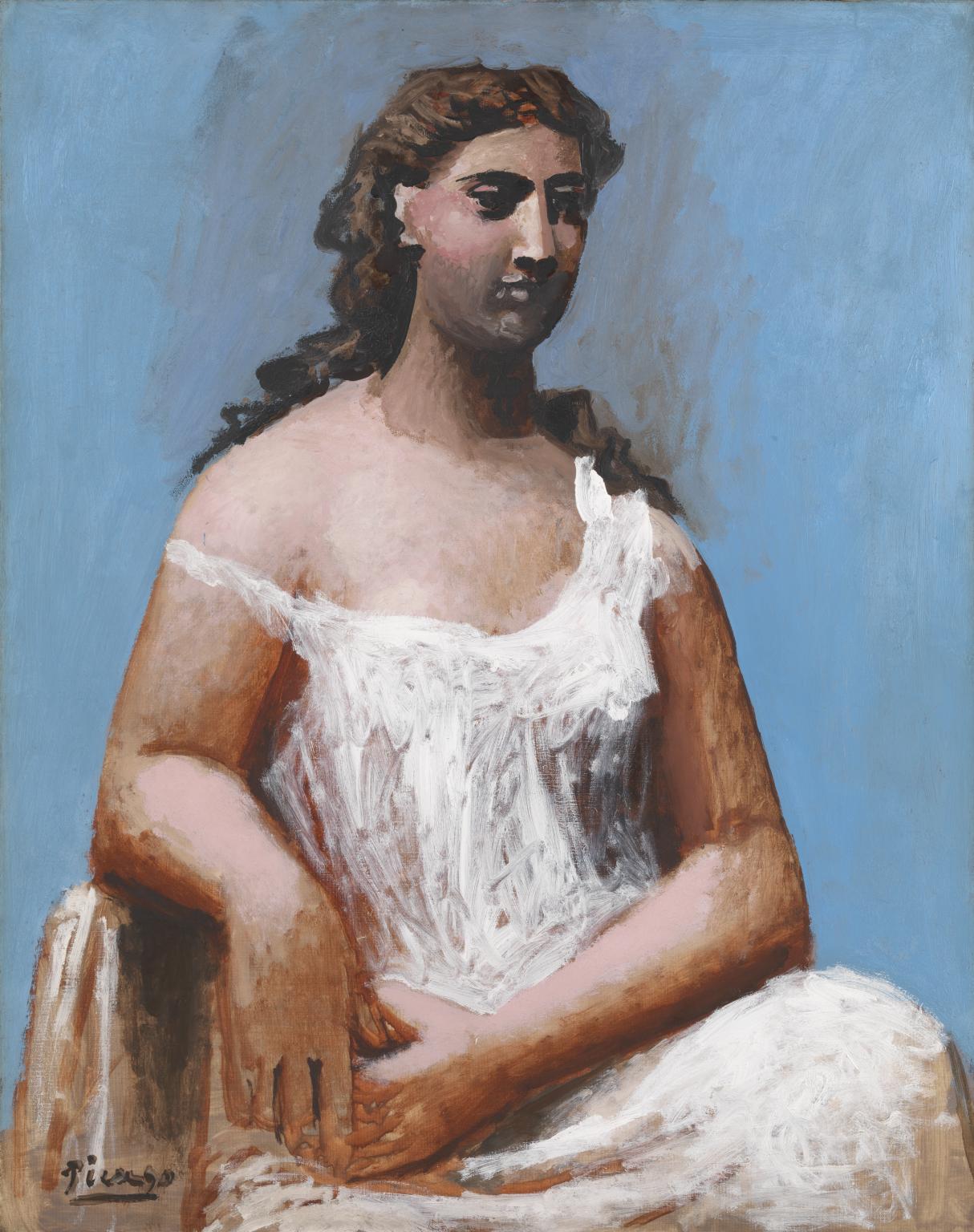
Pablo Picasso, Seated Woman in a Chemise 1923
From 1917 Picasso made overt reference to the art of the ancient world in many of his paintings. Here the figure's facial features, the soft drapes of her dress and her apparent composure recall the grace and naturalism of fifth-century B.C. Greek sculptures. However, the massiveness of her limbs and her immobility appear to echo earlier antique art, or later Roman copies of Greek models. The ambiguity and potential for irony in this admixture of references were essential elements in Picasso's approach to the art of the past. In this picture the blue sky, as well as the strong light, evoke the Mediterranean.
Gallery label, August 2004
1/21
artworks in Monsieur Vénus
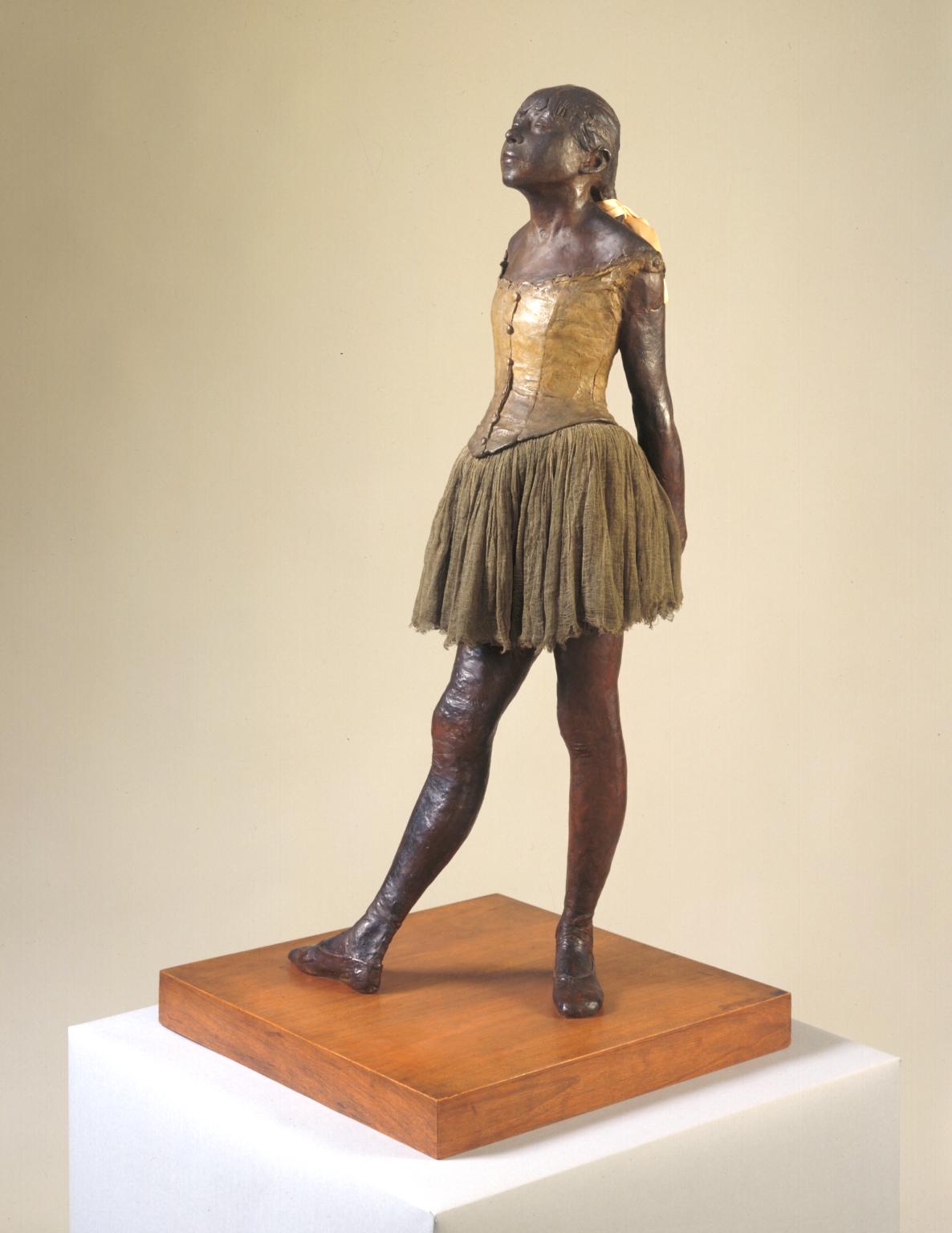
Edgar Degas, Little Dancer Aged Fourteen 1880–1, cast c.1922
The model for this sculpture was ballet student Marie Van Goethem. Degas first made a wax sculpture of her in the nude. Then, aiming for a naturalistic effect, he dressed it in clothing made of real fabrics. When the wax sculpture was first exhibited, contemporaries were shocked by the unprecedented realism of the piece. But they were also moved by the work’s representation of the pain and stress of ballet training endured by a barely adolescent girl. After Degas’ death, his heirs decided to make bronze casts of the wax original.N06076
Gallery label, March 2019
2/21
artworks in Monsieur Vénus

Ernst Ludwig Kirchner, Bathers at Moritzburg 1909–26
From 1909 to 1911 Kirchner and other members of the Brücke group spent part of each summer at the Moritzburg Lakes near Dresden. Their relaxed, communal lifestyle and nude bathing reflected a cult of nature that was growing in Germany at the time. The exaggerated colours in this painting, contrasting yellow-orange flesh with blue water, emphasise the nudity of the figures. The original effect, however, may have been too extreme, as Kirchner repainted parts of the picture in 1926, making the colours lighter and the surface of the painting more even.
Gallery label, July 2008
3/21
artworks in Monsieur Vénus
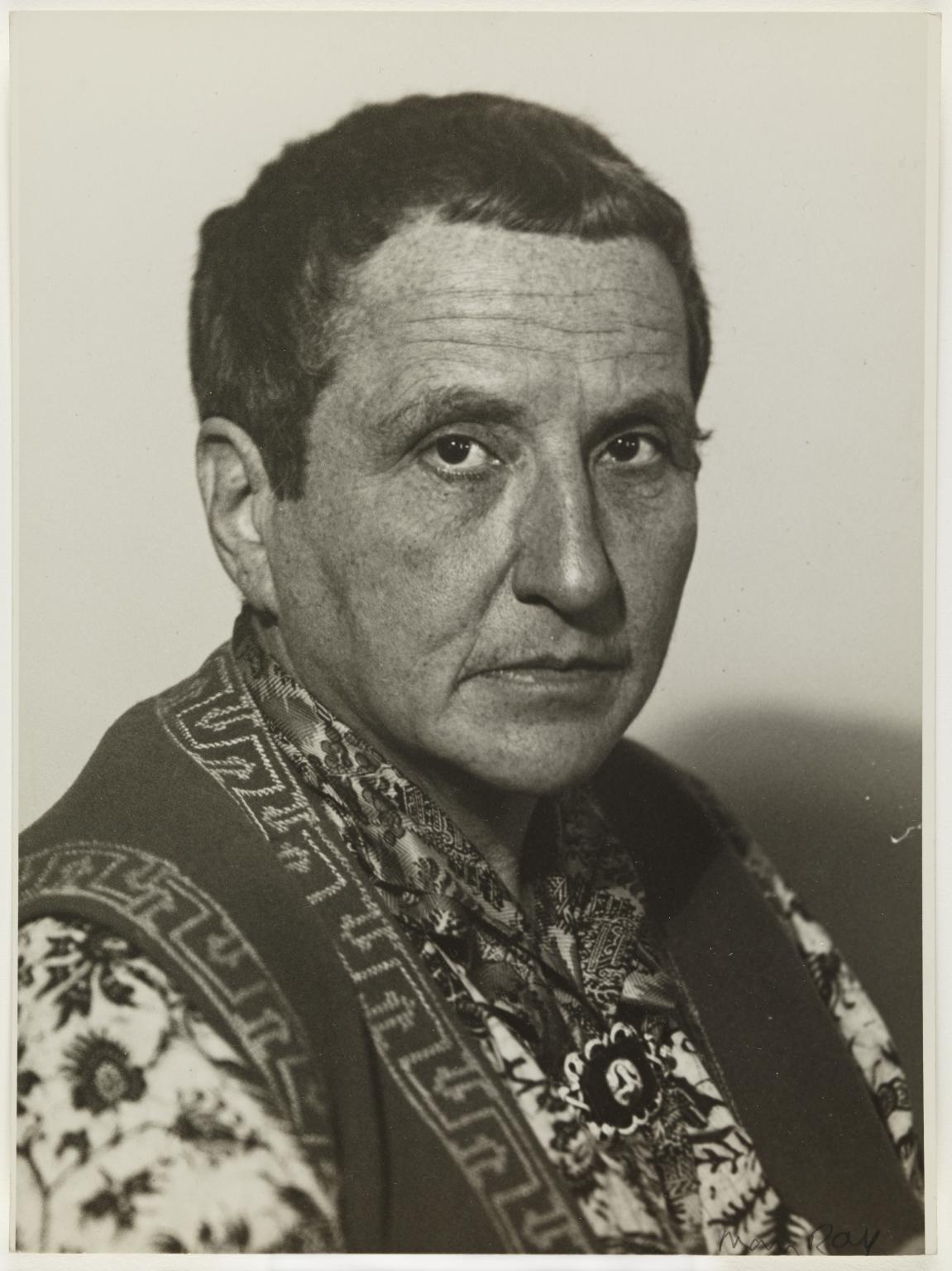
Man Ray, Gertrude Stein c.1920–9
4/21
artworks in Monsieur Vénus
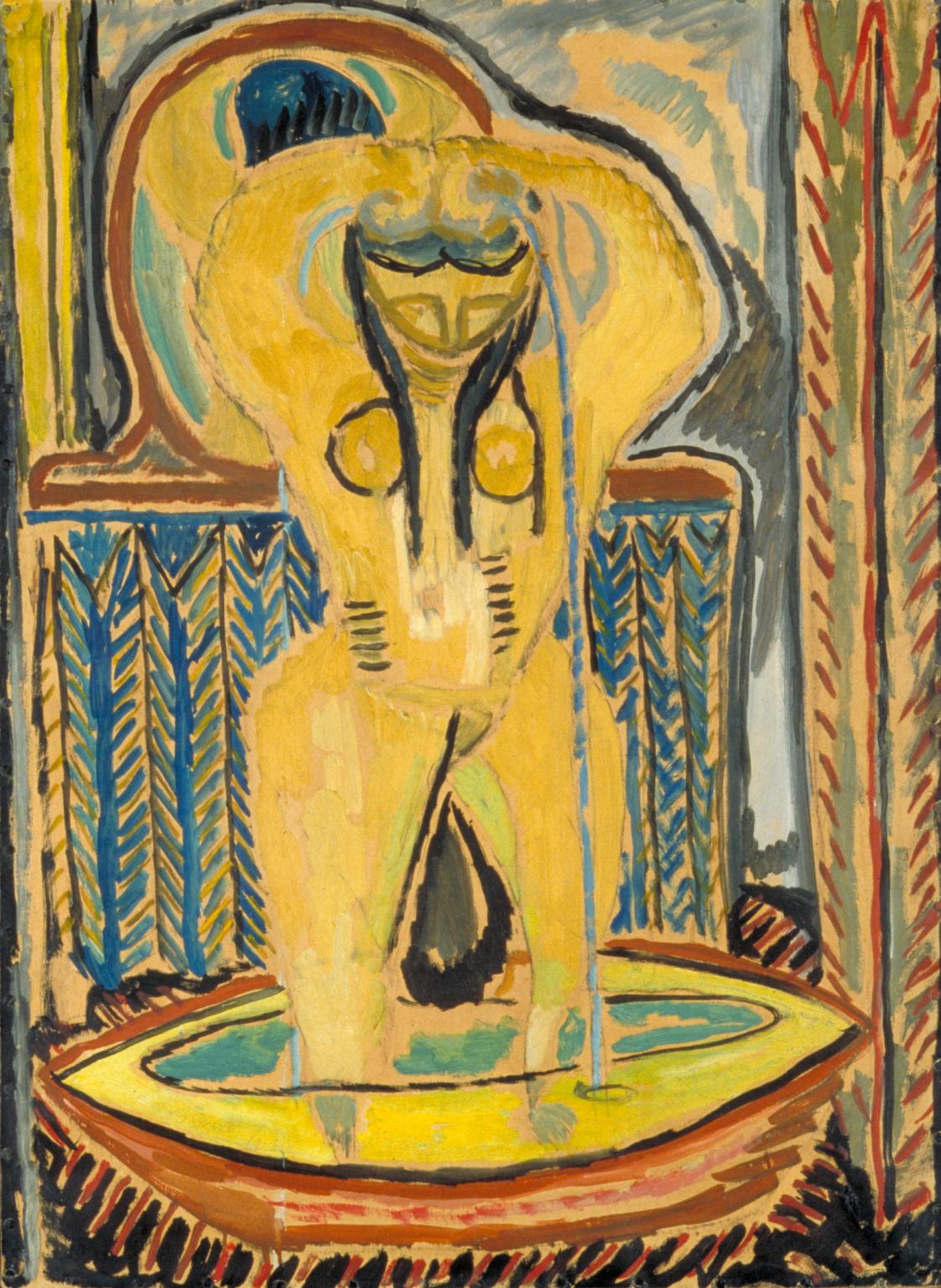
Duncan Grant, The Tub c.1913
Grant went to art school in Paris in 1907, and knew both Matisse and Picasso. Like them he was interested in African sculpture. This interest is echoed here in the figure’s broad hips, tapering legs, flattened round breasts and the simple suggestion of her ribs as well as the hatched patterning of the background.Grant would also have known the writings on African art by Roger Fry, a fellow member of the Bloomsbury Group. Fry argued that what was commonly seen as ‘primitive’ art possessed a raw, erotic passion that had been lost in traditional western painting.
Gallery label, July 2007
5/21
artworks in Monsieur Vénus
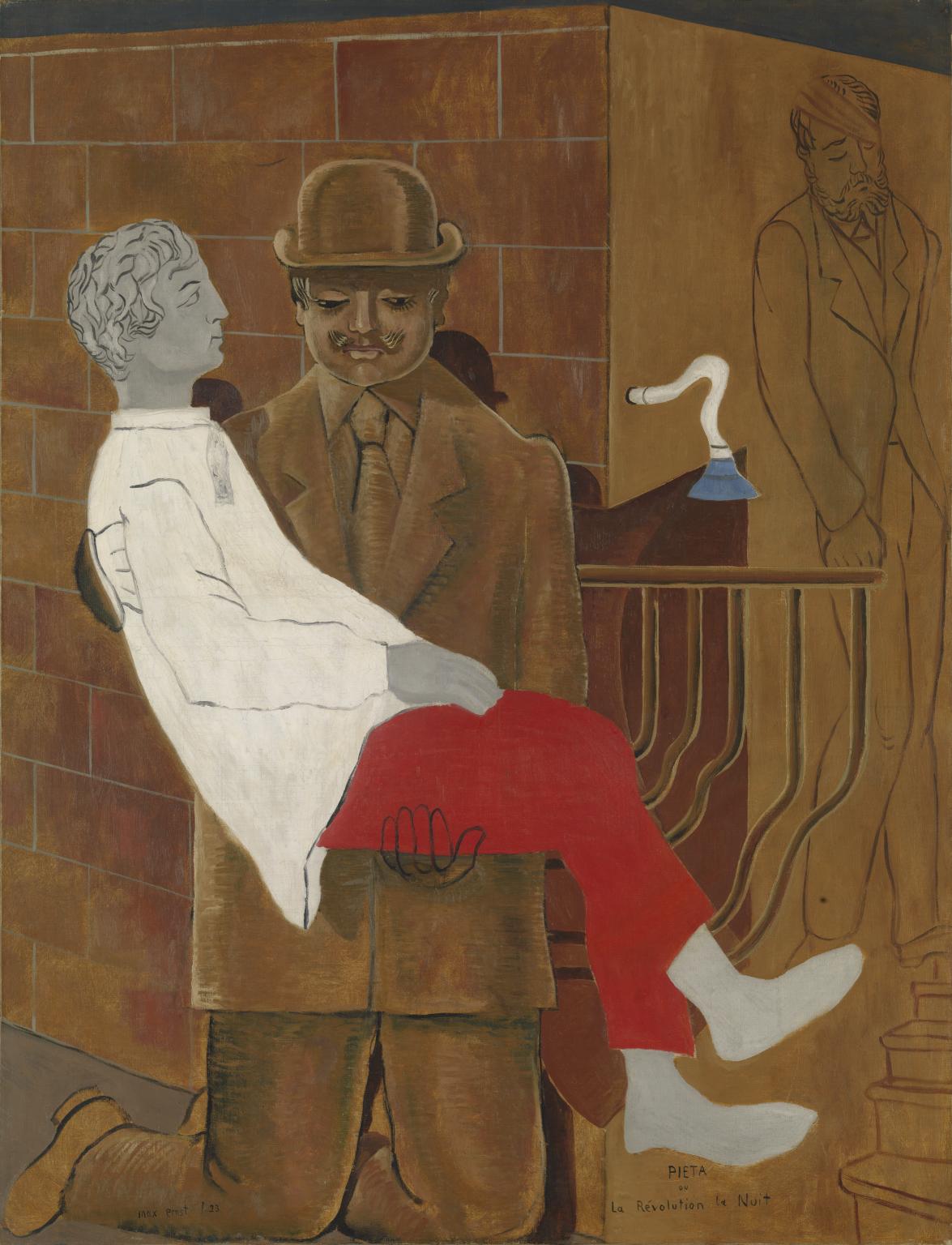
Max Ernst, Pietà or Revolution by Night 1923
In 1924 the poet André Breton published the first Manifesto of Surrealism. The primary aim of this literary and artistic movement was, he explained: 'to resolve the previously contradictory conditions of dream and reality into an absolute reality, a super-reality.' Inspired by the psychoanalyst Sigmund Freud's theory of the unconscious, Surrealism used irrational images to portray the working of the human mind. Max Ernst's Pietà or Revolution by Night is typical. The painting replaces the traditional scene of Mary clasping the body of Christ with an image of the artist himself, held by his father. A staunch Catholic, Ernst's father had denounced his son's work, and the painting is often seen as rising out of their troubled relationship, although - like dreams - it resists precise analysis. Other Surrealists included the poets Paul Eluard and Louis Aragon, and the artists René Magritte, Salvador Dalí and Joan Miró. Purges and defections meant that by 1939 the strength of the group had dissipated. However, it was not formally disbanded until 1968.
Gallery label, August 2004
6/21
artworks in Monsieur Vénus
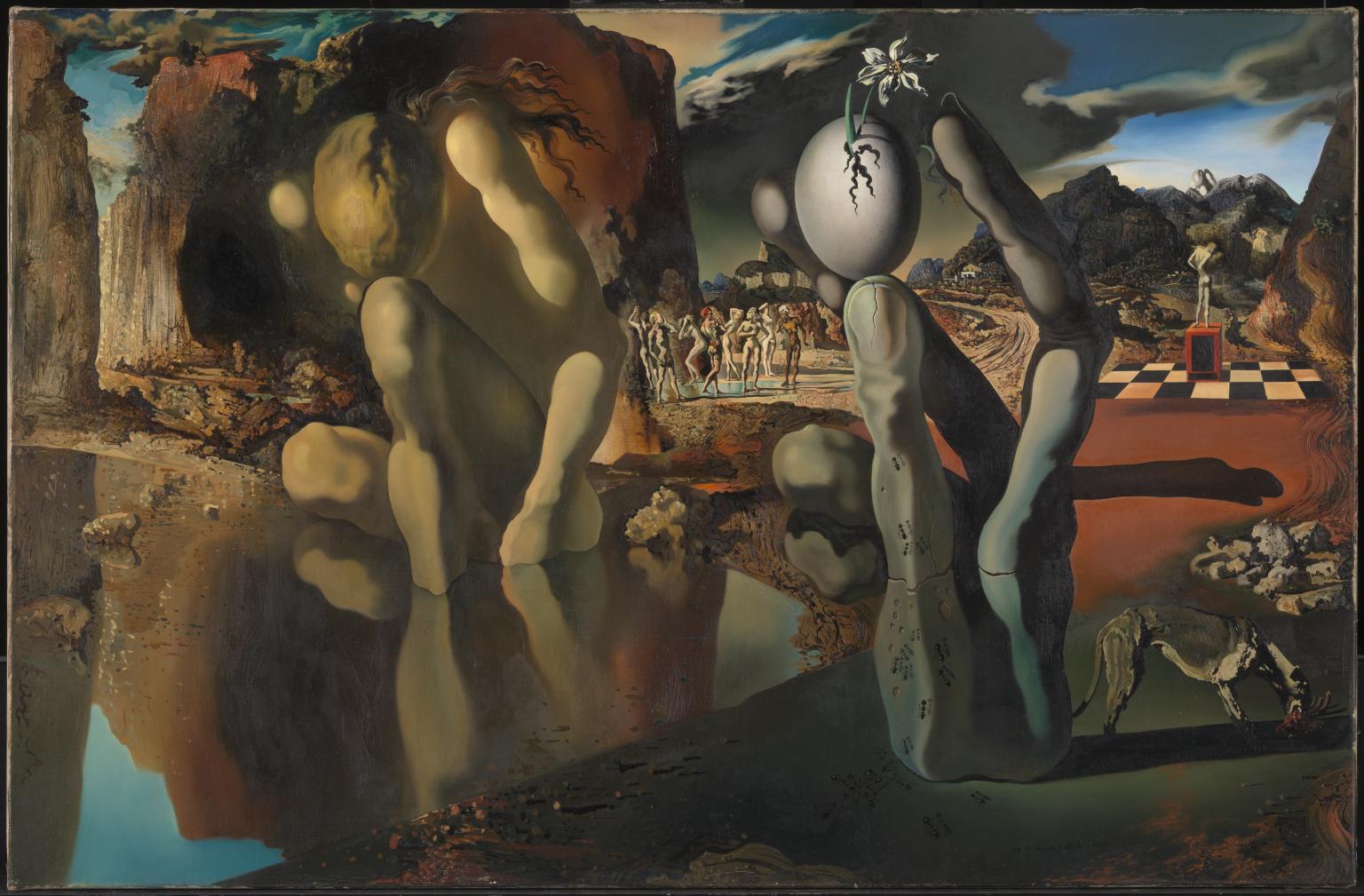
Salvador Dalí, Metamorphosis of Narcissus 1937
According to Greek mythology, Narcissus fell in love with his own reflection in a pool. Unable to embrace the watery image, he pined away, and the gods immortalised him as a flower. Dalí shows this metamorphosis by doubling a crouching figure by the lake with a hand clutching an egg, from which the narcissus flower sprouts. When this painting was first exhibited it was accompanied by a long poem by Dalí. Together, the words and image suggest a range of emotions triggered by the theme of metamorphosis, including anxiety, disgust and desire.
Gallery label, October 2016
7/21
artworks in Monsieur Vénus

Franciszka Themerson, Stefan Themerson, Frame from The Eye and the Ear 1945, printed c.1950s–1970s
Frame from the Eye and the Ear is a black and white gelatin silver print made by Franciszka and Stefan Themerson in 1945 and printed at a later date, sometime between the 1950s and the 1970s. It is a film still printed from one single frame taken from the artists’ film The Eye and the Ear 1944–5. This was the Themersons’ final film and was made in England after the artists relocated permanently to London in the early 1940s. The film consists of four parts, each based on a song from Polish composer Karol Szymanowski’s Słopiewnie. The frame captured in this work is from the fourth and final section of the film and depicts a hand reaching in from the right side of the image, touching a small object which is submerged in a layer of water. The hand creates a rippling pattern in the water, which is captured in detail on the film. When talking about the experimental techniques used in their film practice Stefan Themerson explained: ‘We planned Europa not as an experiment in this sense but as a work of art. Yet The Eye and the Ear was done as a consciously designed experiment. Not every avant-garde dealt with experiments and not every experiment equalled avant-garde.’ (Quoted in Giżycki 1987.)
8/21
artworks in Monsieur Vénus
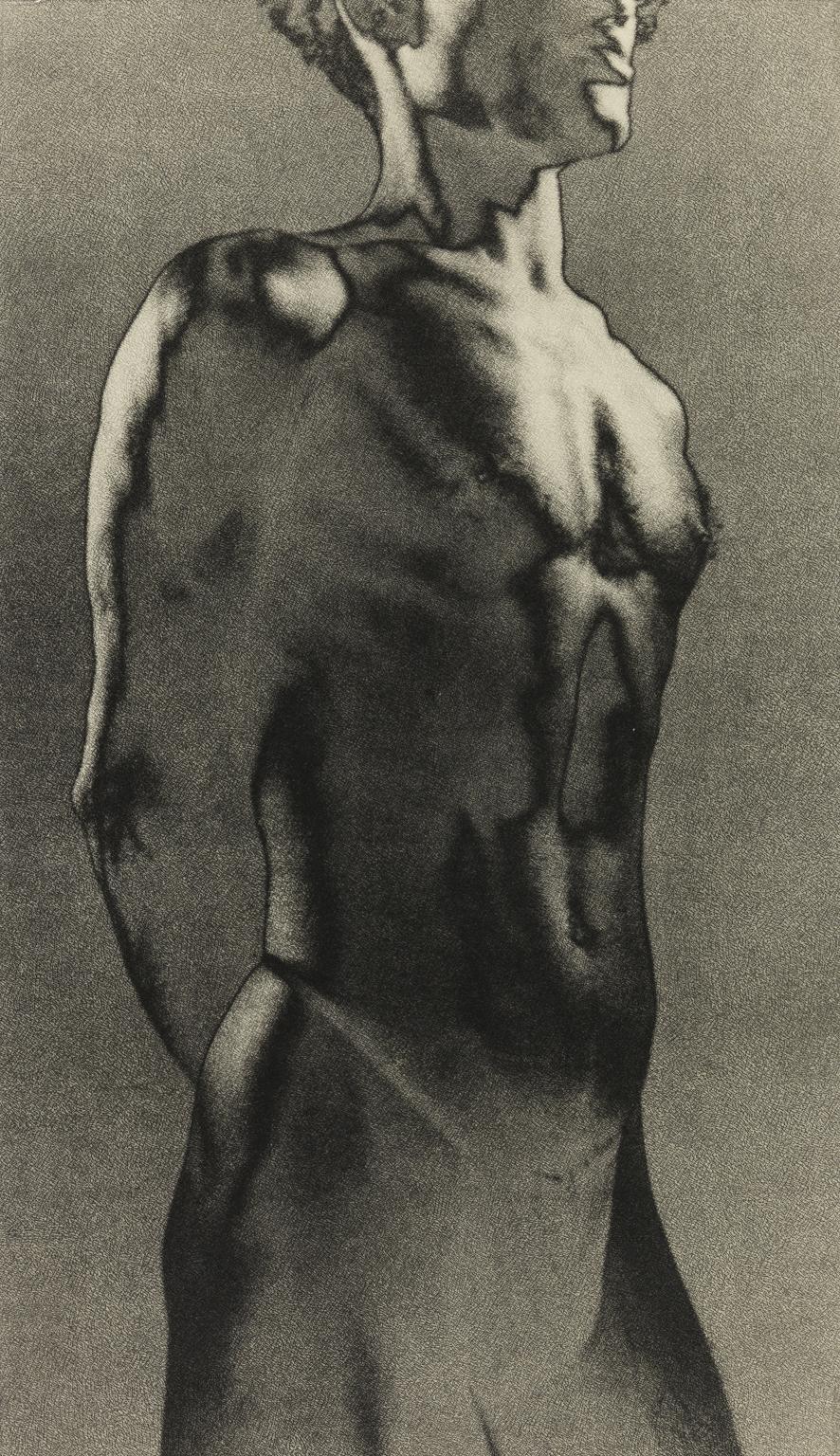
Lionel Wendt, Untitled after 1934
This photograph is a vintage print by Sri Lankan photographer Lionel Wendt. It presents a solarised study of the male form, printed in an unusually large format. The figure is cropped at mid-thigh and mid-head, indicating that it is less a portrait than a formal figure study. Wendt produced several series of formal figurative studies, largely male and some female. His interest in Ceylonese dance and music led him to document Kandian dancers as well as scenes of everyday life, and some of the subjects are known to have become regular models. His attitude towards the human form was informed by classical Greco-Roman poses and statuary, the figures selected for their defined musculature and idealised bodies. In photographs set outdoors they are combined with local references, while in more intimate studio images the subjects are in staged and formal poses, often with selected props.
9/21
artworks in Monsieur Vénus

Henri Matisse, Nude Study in Blue c.1899–1900
Matisse has not disguised the fact that this figure is a model posing in a teaching studio, probably the Académie Carrière in Paris. His principal concern lay with the structure and proportion of the body, and the model’s sinuous pose anticipates the more stylised arabesque figures of his later paintings. Her surroundings are sketched in with broad brushstrokes, becoming abstract planes of colour.
Gallery label, January 2009
10/21
artworks in Monsieur Vénus

Louise Bourgeois, Fillette (Sweeter Version) 1968–99, cast 2001
The title of this phallic sculpture means ‘little girl’, an ironic and unsettling disconnect between word and object. Bourgeois has talked about this work in relation to her experiences as a wife and a mother to three boys. This led her to see masculinity as far more vulnerable than she had imagined. ‘From a sexual point of view I consider the masculine attributes to be extremely delicate’, she explained. ‘They’re objects that the woman, myself, must protect.’ The photographer Robert Mapplethorpe famously portrayed Bourgeois with a version of this work tucked playfully under her arm.
Gallery label, August 2020
11/21
artworks in Monsieur Vénus

Sylvia Sleigh, The Bride (Lawrence Alloway) 1949
12/21
artworks in Monsieur Vénus
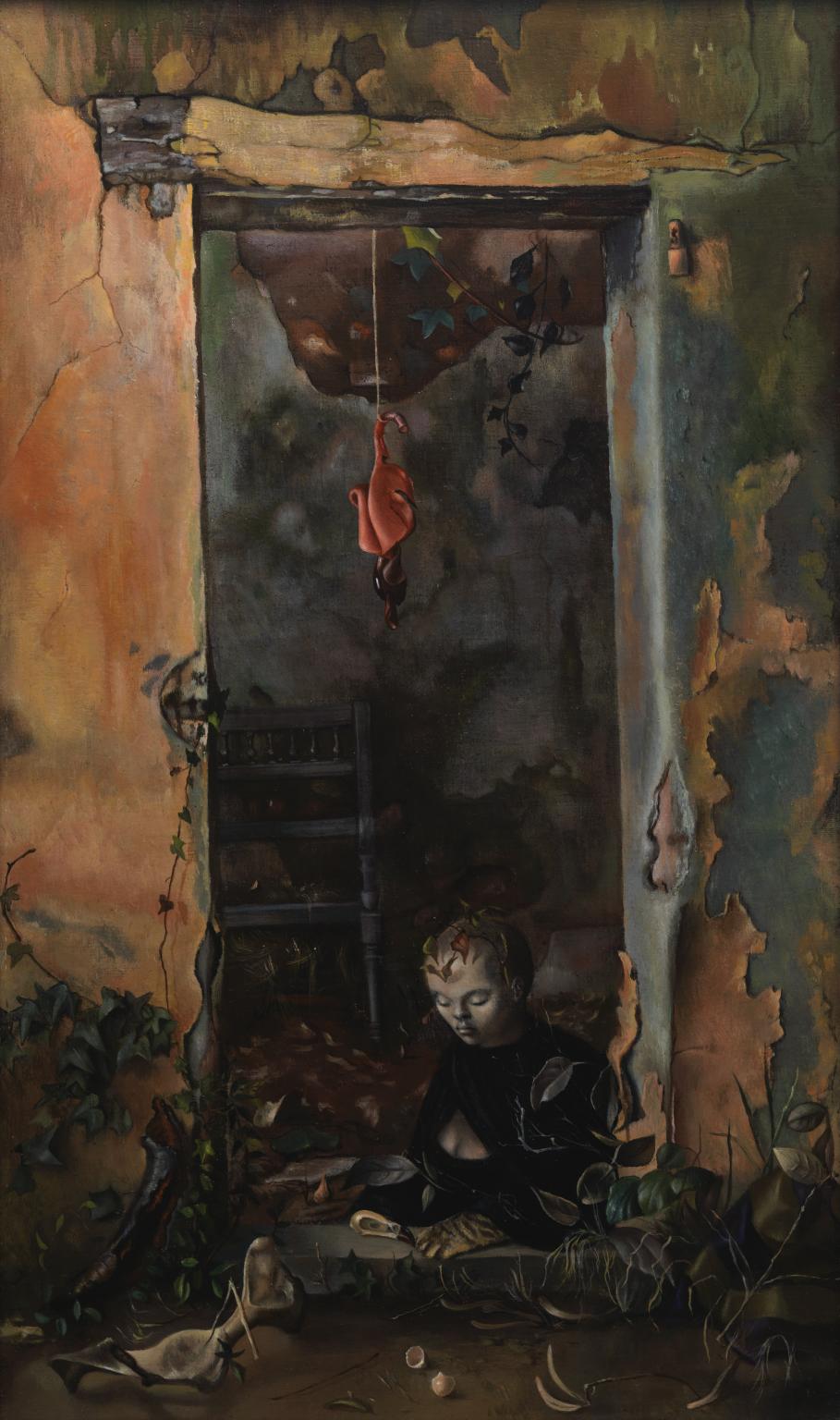
Leonor Fini, Little Hermit Sphinx 1948
The scene in this painting is an unsettling one. It shows the open doorway of an overgrown building, with peeling paintwork. Hanging from the doorway is an internal organ – identified by Fini as a human lung. Sitting among leaves is the Sphinx (a mythological hybrid of a lion and woman). Fini adored cats and used the image of the Sphinx partly as a self-portrait. She regarded it as a symbolic mediator between the human and animal worlds. For her it also connected the conscious and the uncharted areas of the mind and spirit. Here the Sphinx appears as a child-like creature, sitting in front of its ramshackle home. The bird skull at its feet and the organ hanging in the doorway, however, hint at acts of violence.
Gallery label, August 2020
13/21
artworks in Monsieur Vénus
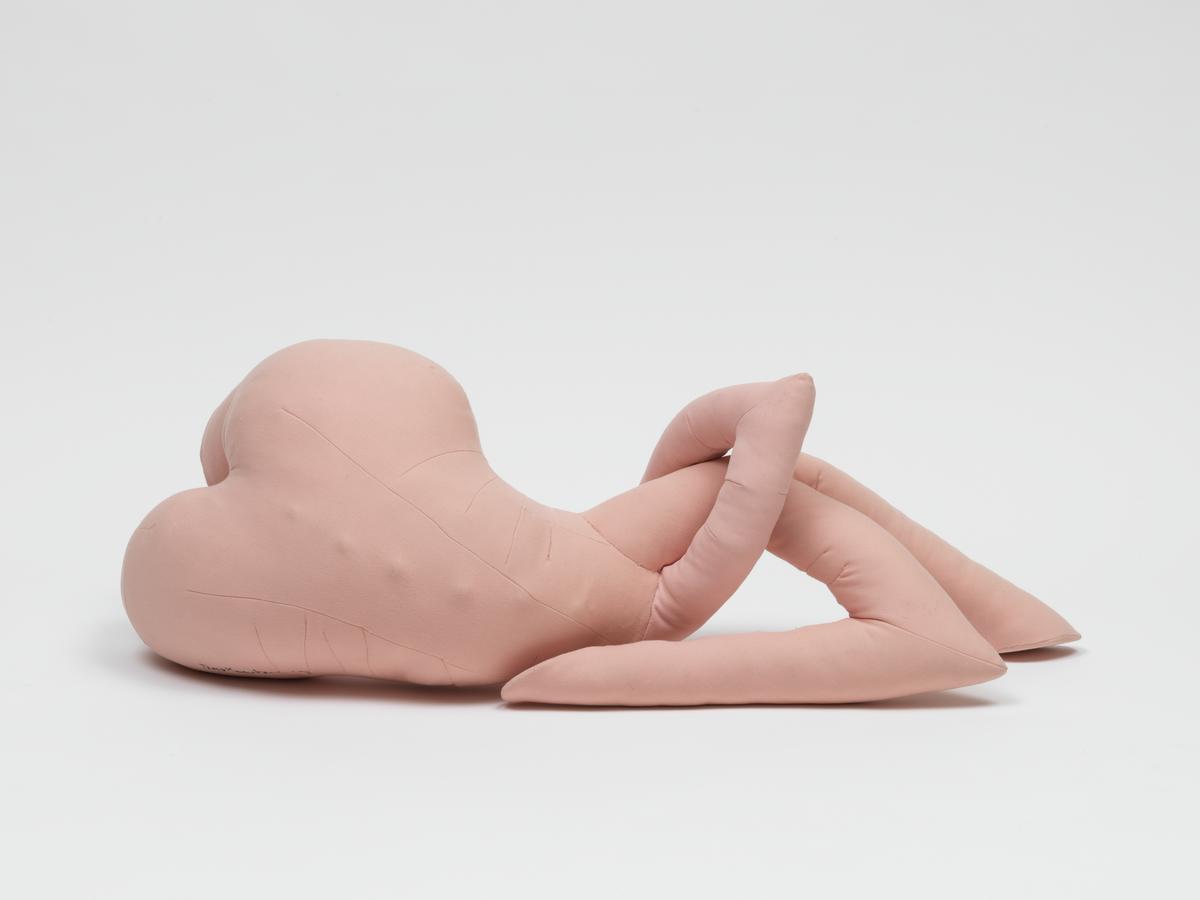
Dorothea Tanning, Nue couchée 1969–70
The title of this work can be translated as ‘Reclining nude’. It is one of a small group of soft sculptures made by Tanning, an American artist who first became associated with the Surrealist group in New York in the early 1940s. The sculptures were three-dimensional expressions of the fantastical images and narratives of her paintings. Here the rounded forms, the suggestion of vertebrae made by table tennis balls inside the work, and the limb-like extrusions wittily evoke a nude of surprising vitality and sensuality.
Gallery label, September 2004
14/21
artworks in Monsieur Vénus
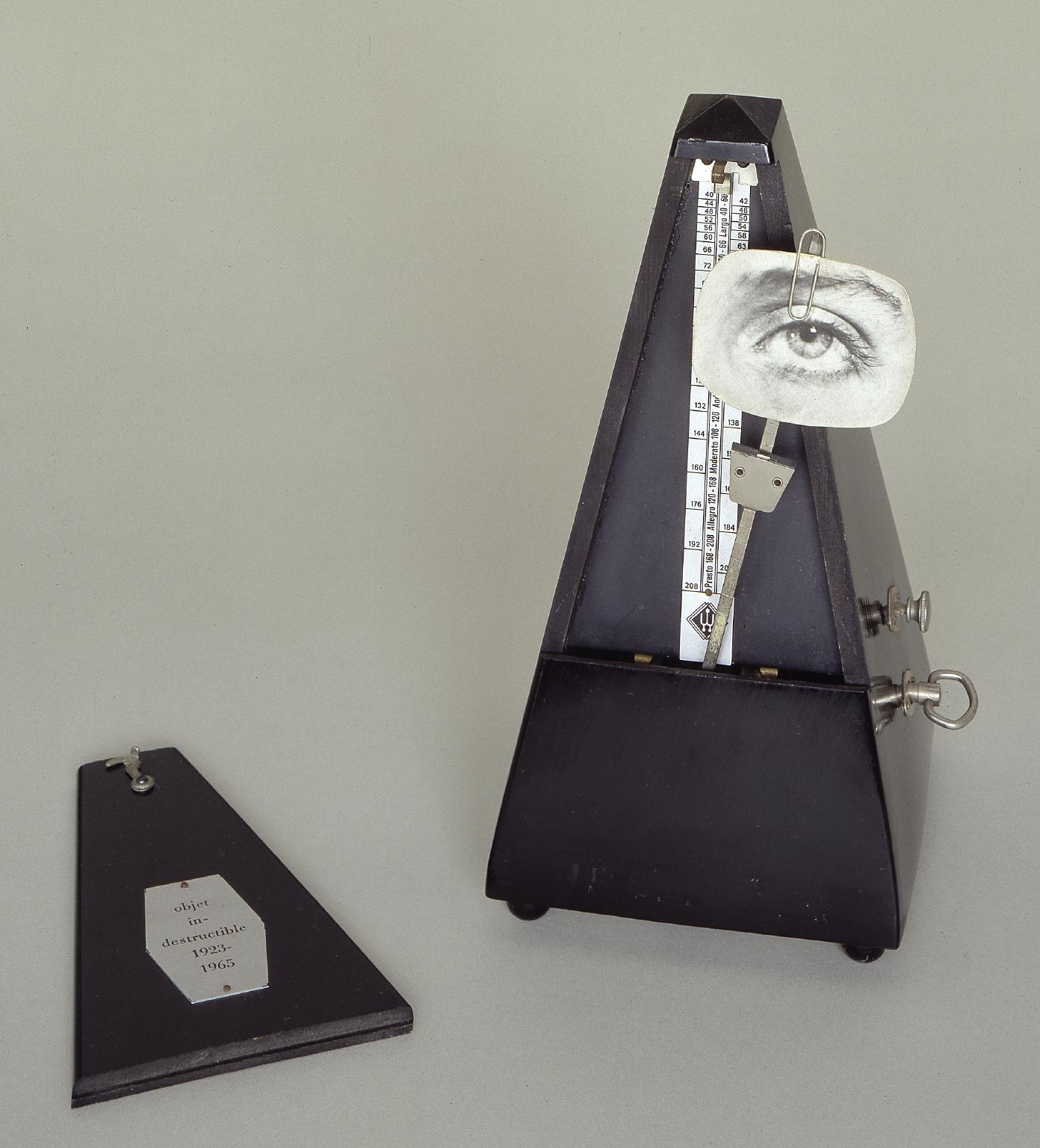
Man Ray, Indestructible Object 1923, remade 1933, editioned replica 1965
Man Ray made the first version of this object shortly after his companion, the American photographer and model Lee Miller, left him. Attaching a photograph of Miller’s eye to the metronome, he linked his memory of her to the idea of an insistent beat or pulse that was both irksome and unending – a metaphor, perhaps, for human desire. He smashed the original, which he had titled Object to be Destroyed. This later version, produced in an edition of 100, was called Indestructible Object because, he suggested, ’it would be very difficult to destroy all hundred’
Gallery label, September 2004
15/21
artworks in Monsieur Vénus
Kati Horna, Ascent to the Cathedral, Spanish Civil War, Barcelona, Spain 1937 1937
Ascent to the Cathedral, Spanish Civil War, Barcelona, Spain 1937 is a photographic print that blends three images, created either by a superimposed photomontage technique or the use of a three-negative printing process. The first image, a portrait of a woman, is seamlessly merged with a second image of a brick building with two barred windows and a stairway at the bottom. In bringing the two images together, Horna has created a surreal scene. One of the woman’s eyes peeks through the bars of one of the windows, the upper edge of which becomes her brow. The steps in the lower quarter of the image rise at an angle, suggesting that this gigantesque woman is looking over the stairway.
16/21
artworks in Monsieur Vénus
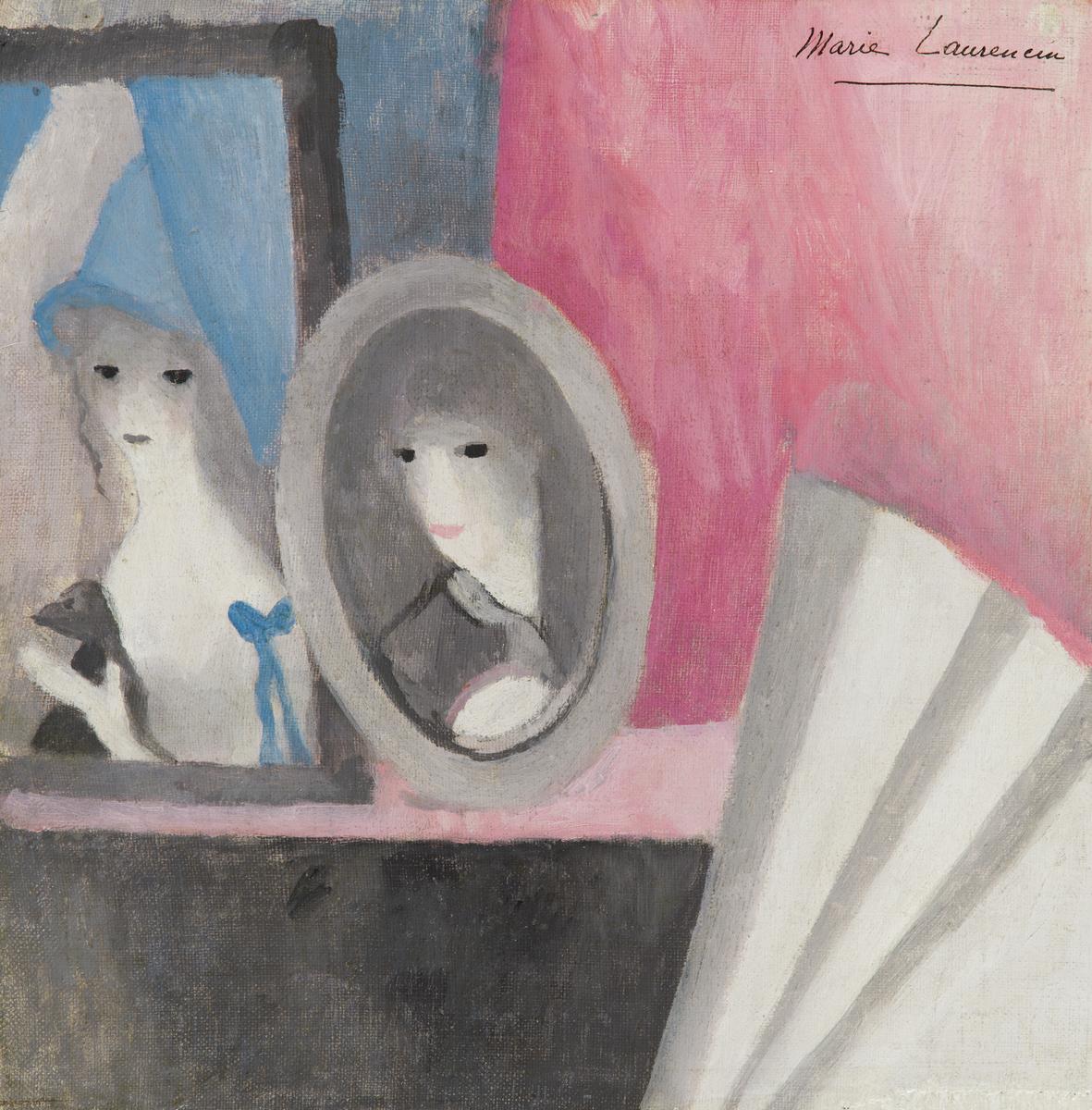
Marie Laurencin, The Fan c.1919
The Fan was Elly Kahnweiler’s personal property and is thought to have been Gustav’s wedding present to her. It has been suggested that the woman in the oval frame is the artist herself. The identification of the other, however, is uncertain. The image is intriguingly ambiguous: the frames, for example, may represent mirrors, or pictures within the picture. The fan, which was a symbol of vanity and one of Laurencin’s favourite accessories, may indicate the presence of another person in the room.
Gallery label, May 2004
17/21
artworks in Monsieur Vénus
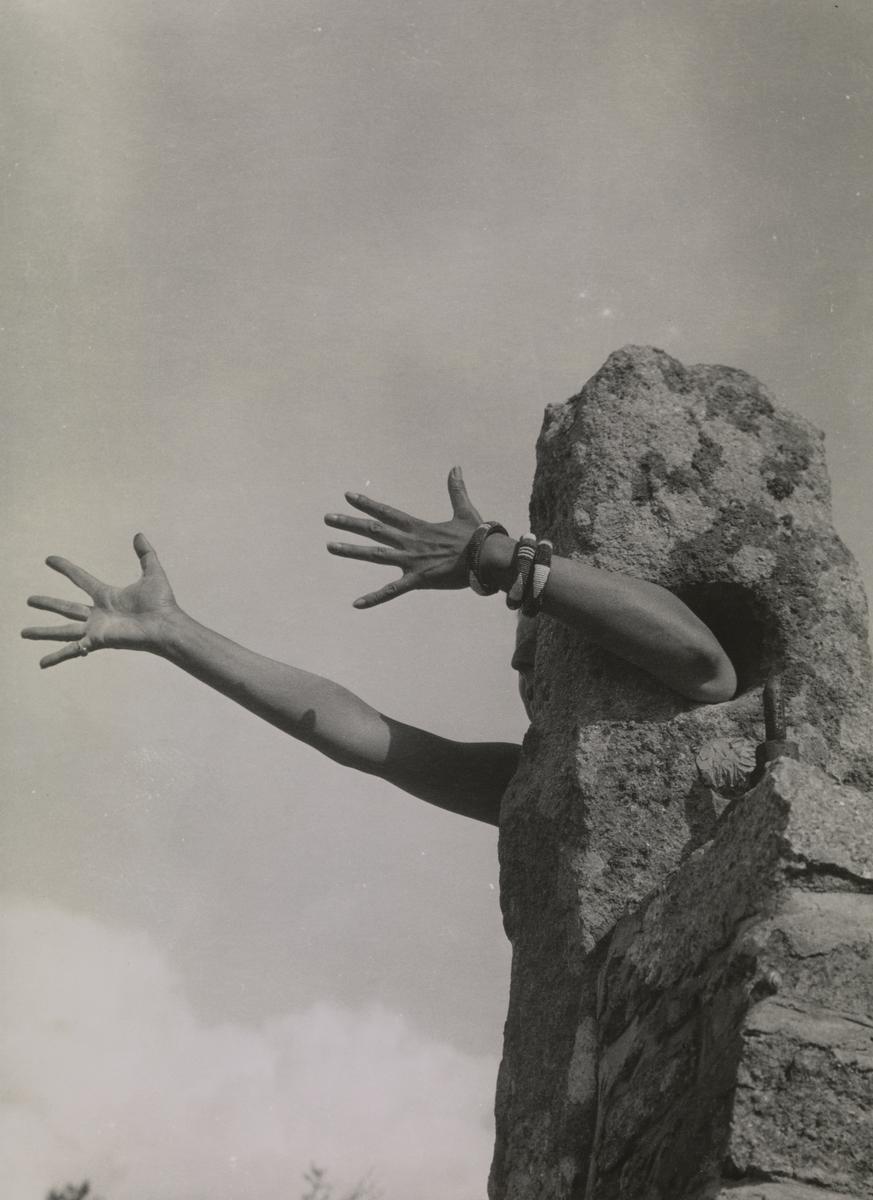
Claude Cahun, I Extend My Arms 1931 or 1932
In this photograph, Cahun could be said to be ‘wearing’ the rock as a mask or costume. At the same time the work brings alive an inanimate object. It relates both to her interest in performing different identities and to the surrealist celebration of surprising and resonant combinations.
Gallery label, October 2016
18/21
artworks in Monsieur Vénus
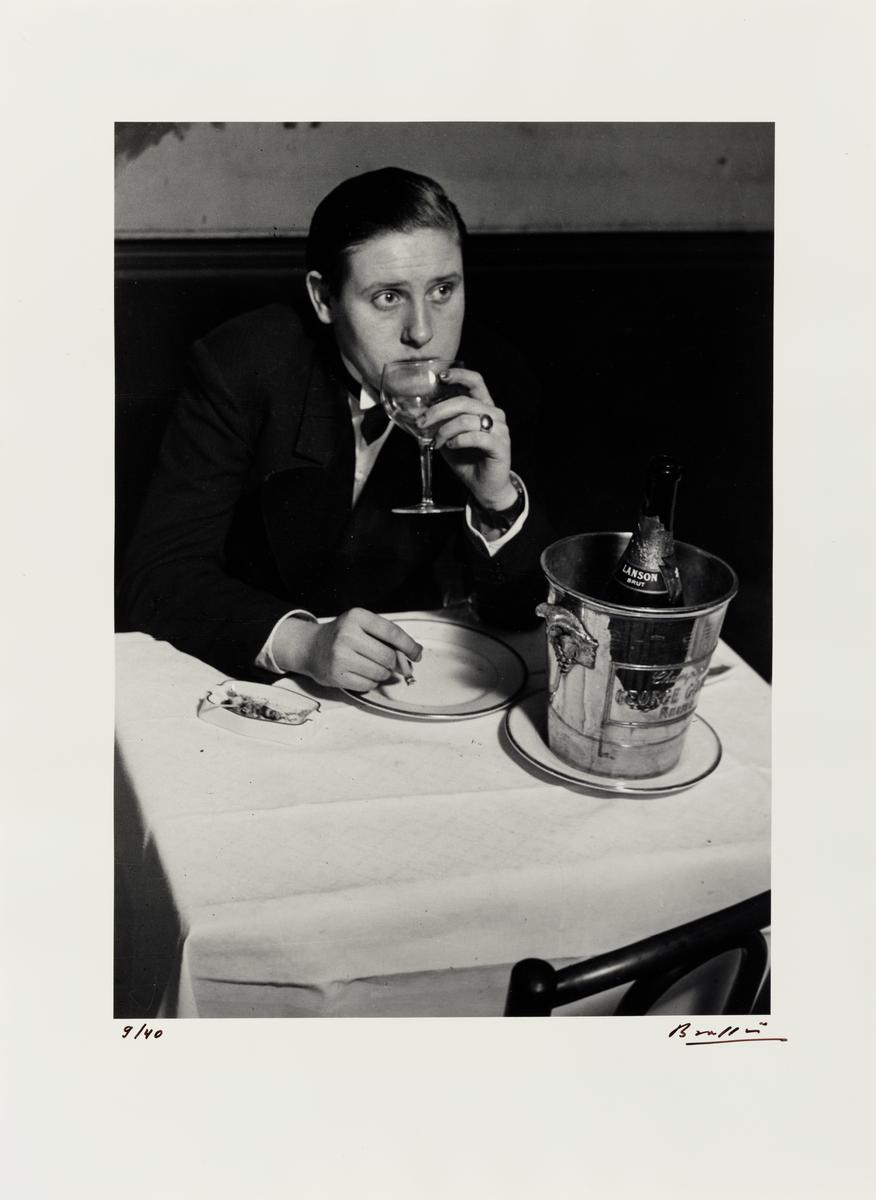
Brassaï, Young Lesbian at Monocle 1932, printed later
Young Lesbian at Monocle 1932 is a medium-size black and white photograph by the Hungarian photographer Brassaï that depicts a woman sitting at a table in a bar or restaurant. Her surroundings suggest opulence: the table is covered with a white tablecloth and on this are placed two silver-rimmed plates and an ornate silver ice bucket bearing the branding of the high-class French champagne company George Goulet, inside which is a bottle produced by another prestigious champagne maker, Lanson Brut. The woman holds a near-empty glass to her lips with her left hand, while in the other is a cigarette. She wears smart, masculine-looking clothes – a suit, a cravat and a large gold ring – that reflect her elegant surroundings, and her hair is waxed down with pomade, accentuating her masculine appearance. The woman sits on a bench that runs behind the table, and the chair opposite her, visible in the lower right foreground of the scene, is unoccupied. The presence of the empty chair, as well as the melancholy expression on the woman’s face as she gazes towards the right side of the frame, seem to emphasise the subject’s solitude. The photographed scene has a large white margin around it that has been signed in the bottom right corner by the artist, while the bottom left bears an inscription indicating that this print is number nine in an edition of forty.
19/21
artworks in Monsieur Vénus
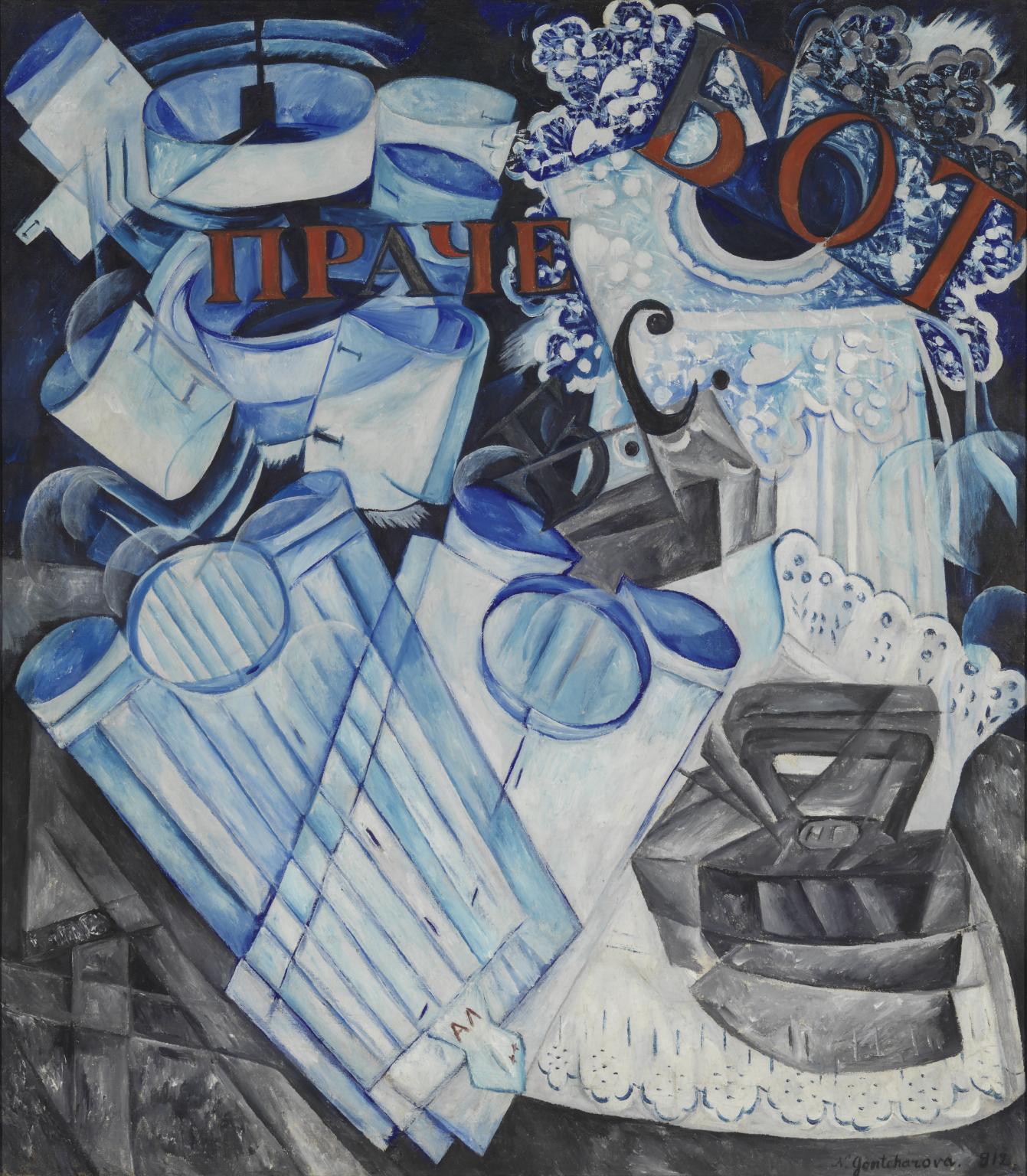
Natalia Goncharova, Linen 1913
The Russian inscriptions suggest a launderette sign: Prache is part of the word for laundry, b.s. is an abbreviation for ‘white wash’, and BOT possibly part of the word rabota meaning ‘work’. The iron bears a monogram with the artist’s initials. This painting conveys the bustle of a commercial laundry but can also be seen as a coded commentary on Goncharova’s relationship with her partner, fellow-artist Michel Larionov. The two sides of the work are divided between male (shirts, collars and cuffs) and female (lace, blouses, aprons) items of laundry.
Gallery label, December 2016
20/21
artworks in Monsieur Vénus
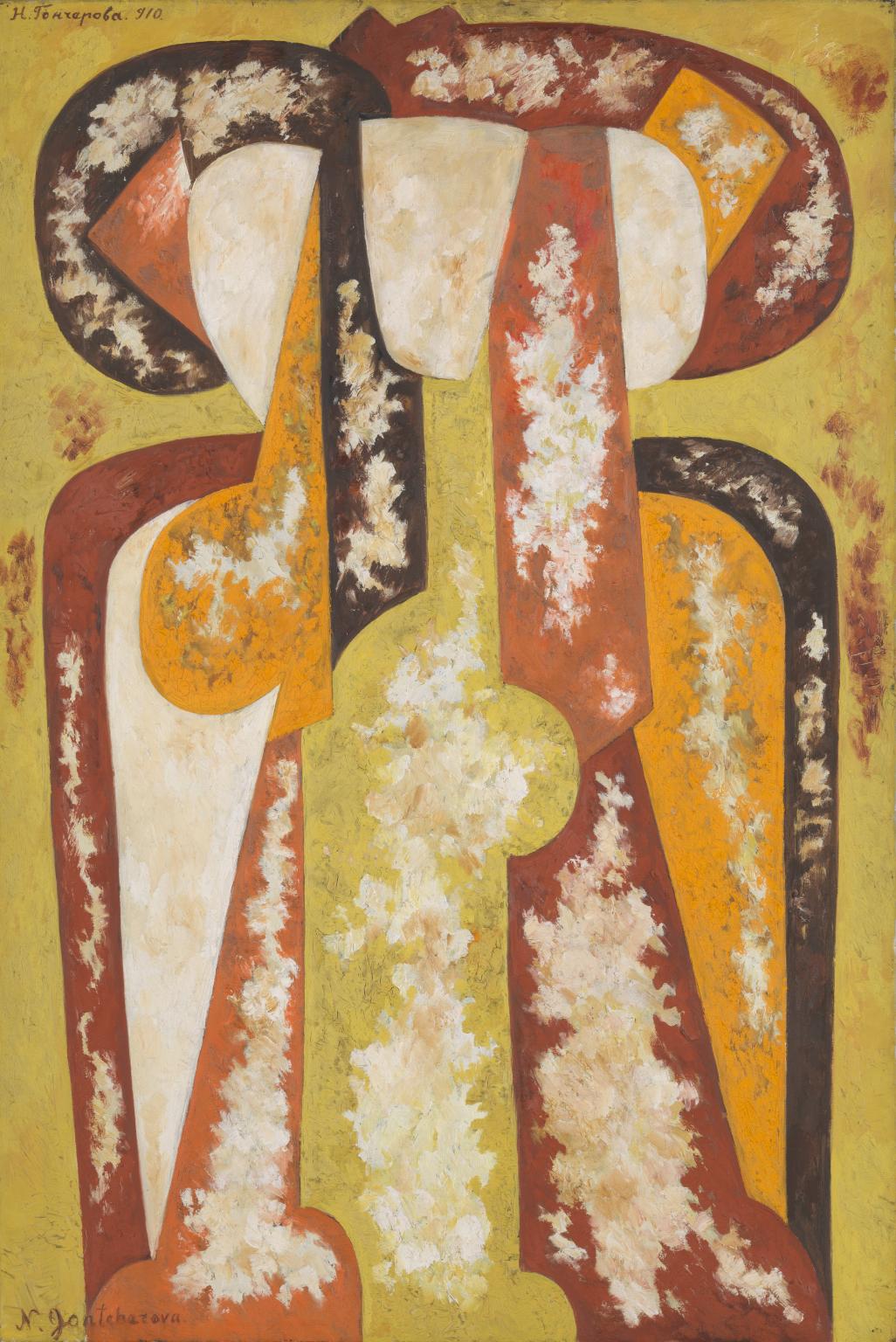
Natalia Goncharova, Three Young Women 1920
The apparent abstraction of this composition derives from the radically restructured forms of the three women identified in the title. Many years after its completion, the artist described it as: ‘Three half-length female figures, the play of sunlight and reflections of a sandy path (yellowish orange) and orange red etc.’ The fragmented forms that Goncharova favoured in earlier works were here resolved in a more stable synthesis that reflect her contribution to developments in post-First World War Paris.
Gallery label, November 2007
21/21
artworks in Monsieur Vénus
Art in this room















Sorry, no image available





You've viewed 6/21 artworks
You've viewed 21/21 artworks
